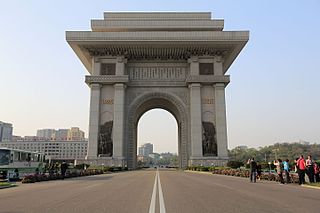
Pyongyang is the capital and largest city of North Korea, where it is sometimes labeled as the "Capital of the Revolution". Pyongyang is located on the Taedong River about 109 km (68 mi) upstream from its mouth on the Yellow Sea. According to the 2008 population census, it has a population of 3,255,288. Pyongyang is a directly administered city with a status equal to that of the North Korean provinces.
Korea has had administrative districts that can be considered provinces since the 7th century. These divisions were initially called ju in Unified Silla and Later Baekje, and there were nine in total. After Goryeo conquered these states in the 10th century, twelve divisions called mok were established, although they were reorganized into ten do in the 11th century.
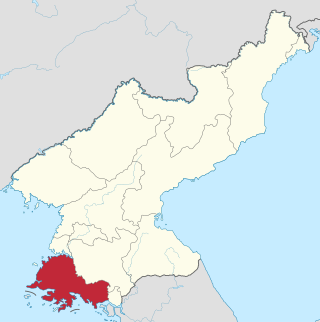
South Hwanghae Province is a province in western North Korea. The province was formed in 1954 when the former Hwanghae Province was split into North and South Hwanghae. The provincial capital is Haeju.

North Hwanghae Province is a province of North Korea. The province was formed in 1954 when the former Hwanghae Province was split into North and South Hwanghae. The provincial capital is Sariwon. The province is bordered by Pyongyang and South Pyongan to the north, Kangwon to the east, Kaesong Industrial Region and South Korea's Gyeonggi Province to the south, and South Hwanghae southwest. In 2003, Kaesong Directly Governed City became part of North Hwanghae as Kaepung County. Later on in 2019, it was promoted as Special City. Thus, it was separated from North Hwanghae.

Kaesong is a special city in the southern part of North Korea, and the capital of Korea during the Taebong kingdom and subsequent Goryeo dynasty. The city is near the Kaesong Industrial Region close to the border with South Korea and contains the remains of the Manwoldae palace. Called Songdo while it was the ancient capital of Goryeo, the city prospered as a trade centre that produced Korean ginseng. Kaesong now functions as North Korea's light industry centre.

South Pyongan Province is a province of North Korea. The province was formed in 1896 from the southern half of the former Pyongan Province, remained a province of Korea until 1945, then became a province of North Korea. Its capital is Pyongsong.

North Hamgyong Province is the northernmost province of North Korea. The province was formed in 1896 from the northern half of the former Hamgyong Province.

The Kaesŏng Industrial Region (KIR) or Kaesŏng Industrial Zone (KIZ) is a special administrative industrial region of North Korea (DPRK). It was formed in 2002 from part of the Kaesŏng Directly-Governed City. On 10 February 2016, it was temporarily closed by the South Korean government and all staff recalled by the Park Geun-hye administration, although the former President of South Korea, Moon Jae-in, signalled his desire to "reopen and expand" the region in 2017.
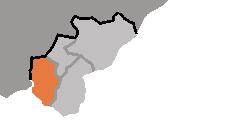
Kaep'ung-guyŏk is a district of Kaesong Special city in North Korea. Formerly part of the Kaesong urban area, the county was merged with North Hwanghae when Kaesong was demoted in 2003. However, it was returned to Kaesong Special City in October 2019.

Pyongyang station is the central railway station of Pyongyang, North Korea. It is located in Yŏkchŏn-dong, Chung-guyŏk.

The P'yŏngbu Line is an electrified standard-gauge trunk line of the Korean State Railway running from P'yŏngyang to Kaesŏng in North Korea and further south across the DMZ to Seoul in South Korea; the name comes from the two (theoretical) termini of the line: P'yŏngyang and Busan.

Gyeonggi, alternatively spelled Kyŏnggi or Kyunggi, is a region of the Korean Peninsula that has historically occupied the west-central region of Korea. In modern times, the region hosts South Korea's Gyeonggi Province and Incheon Metropolitan City, and North Korea's Kaesong Industrial Region, and Changpung, and Ch'ŏrwŏn counties.
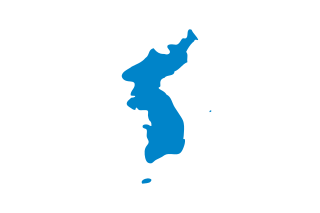
The Inter-Korean Liaison Office (Korean: 남북공동연락사무소) was a joint liaison office of North Korea and South Korea located in North Korea's Kaesong Industrial Region.
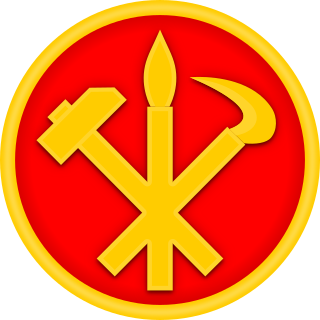
The United Front Department of the Workers' Party of Korea is a department of the Central Committee of the Workers' Party of Korea (WPK) tasked with relations with South Korea. It conducts propaganda operations and espionage and manages front organizations, including the Chongryon.

Cycling has become a common mode of transport in North Korea since its economic transition in the early 1990s.
Events of 2020 in North Korea.
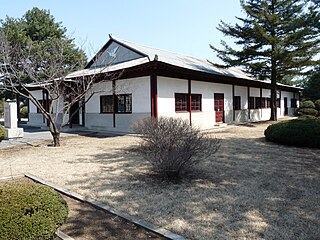
P'anmun-guyŏk is a ward in Kaesong, North Korea.















